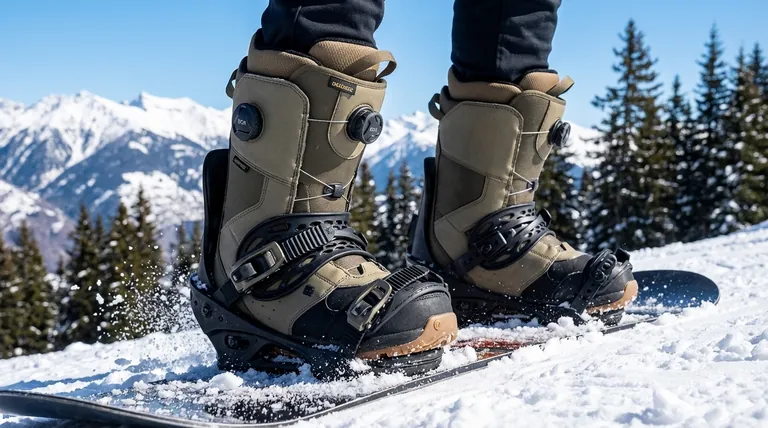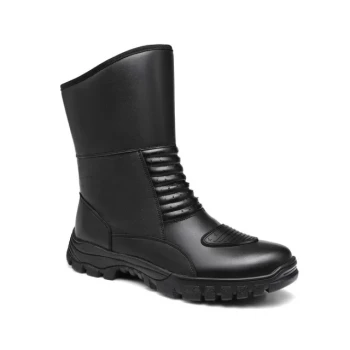Understanding the key features of snowboard boots is about recognizing them as a piece of high-performance equipment, not just footwear. Their most critical features are a stiff, protective outer shell, a separate and comfortable inner liner, and a specialized lacing system designed to lock your foot in place for direct control over your snowboard. These elements work together to translate your body's movements to the board's edges.
The core purpose of a snowboard boot is not walking comfort or all-day warmth like a regular snow boot; it is to provide the rigid support and precise fit necessary to control a snowboard. Every feature is engineered for performance on the board, often at the expense of comfort off it.

The Anatomy of a Snowboard Boot
A snowboard boot is more than a single piece of footwear. It's a system of components, each with a specific job related to fit, comfort, and control.
The Outer Shell: Your Control Center
The most noticeable feature is the bulky, stiff outer boot. This shell is intentionally rigid.
Its primary role is to provide ankle support and efficiently transfer energy from your legs, through the bindings, and into the edge of your snowboard. This stiffness is what gives you control when turning.
The Inner Liner: For Comfort and Fit
Inside the shell is a separate, soft inner boot called a liner. This is what provides cushioning and insulation.
Most liners are heat-moldable, meaning a shop can heat them up so they shape perfectly to your foot, eliminating pressure points and improving control.
The Lacing System: Precision and Hold
How a boot tightens is a critical feature that impacts both convenience and performance. There are three main types:
- Traditional Laces: Simple and offer the most customizable fit, but can be difficult to tighten with gloves on.
- Speed Laces: Use a pull-cord system to quickly tighten different zones of the boot, offering a great balance of speed and custom fit.
- Boa System: A dial-based system that uses a steel cable to tighten the boot. It's extremely fast and easy to adjust on the fly, even with gloves.
The Sole: The Binding Connection
Unlike the flexible, deeply treaded sole of a winter hiking boot, a snowboard boot's sole is relatively flat and rigid.
It's designed specifically to fit snugly into a snowboard binding, creating a seamless connection that ensures your movements are not lost between your foot and the board.
Why You Can't Just Use Regular Snow Boots
Many beginners wonder if their standard winter boots will work for snowboarding. The answer is a definitive no, and the reasons highlight the specialized nature of snowboard boot features.
The Problem of Flex
Regular snow boots are built to be flexible for comfortable walking. This flexibility is the enemy of snowboard control. It would prevent you from putting enough pressure on the board's edges to turn or stop effectively.
The Lack of Ankle Support
The stiff construction of a snowboard boot is crucial for protecting your ankles from the intense forces involved in snowboarding. A standard snow boot offers virtually no support, dramatically increasing the risk of injury.
The Mismatch with Bindings
Snowboard bindings are engineered to hold the specific shape and rigid material of a snowboard boot. A softer, irregularly shaped snow boot will not fit securely, leading to a dangerous lack of control.
Understanding the Trade-offs: Flex vs. Comfort
The most important performance feature of a snowboard boot is its "flex," or how stiff it is. This choice comes with direct trade-offs.
The Flex Rating Spectrum
Boots are generally rated on a 1-10 scale from soft to stiff.
- Soft Flex (1-4): More forgiving and comfortable. Ideal for beginners who need to build confidence and freestyle riders who want more maneuverability for tricks.
- Medium Flex (5-7): The all-around choice. They offer a balance of responsiveness for carving and enough flexibility for varied terrain, making them perfect for all-mountain riders.
- Stiff Flex (8-10): Offer instant response and maximum support. They are built for aggressive, high-speed riders who need precise control for carving and freeriding.
Performance vs. Off-Mountain Comfort
There is a direct relationship between a boot's performance and its off-mountain comfort. The stiffer and more responsive a boot is, the less comfortable it will be for walking around the lodge. This is a deliberate design choice, prioritizing control on the snow above all else.
Making the Right Choice for Your Goal
Selecting the right features comes down to your personal riding style and skill level.
- If you are a beginner or a park rider: Prioritize a boot with a soft to medium flex for forgiveness and a simple, quick lacing system like Boa or Speed Laces for convenience.
- If you are an all-mountain rider: A medium-flex boot is your most versatile option, providing the support you need for high speeds and the flexibility for varied conditions.
- If your primary focus is aggressive freeriding or carving: You need a stiff boot that provides instant power transmission and maximum support for high-impact riding.
Ultimately, the right boot features are the ones that connect you to your board, giving you the confidence and control to ride your best.
Summary Table:
| Feature | Description | Key Benefit |
|---|---|---|
| Outer Shell | Stiff, rigid construction | Provides ankle support and direct energy transfer for control |
| Inner Liner | Soft, heat-moldable boot inside the shell | Ensures comfort, insulation, and a custom fit |
| Lacing System | Traditional laces, Speed Laces, or Boa System | Offers customizable fit, speed, and ease of adjustment |
| Sole | Flat and rigid design | Securely connects to snowboard bindings for precise movement |
| Flex Rating | Scale from 1 (soft) to 10 (stiff) | Matches riding style (beginner, all-mountain, or aggressive) |
Ready to equip your customers with high-performance snowboard boots? As a large-scale manufacturer, 3515 produces a comprehensive range of footwear for distributors, brand owners, and bulk clients. Our production capabilities encompass all types of shoes and boots, including specialized snowboard boots designed for performance, durability, and perfect fit. Partner with us to deliver quality gear that enhances rider confidence and control. Contact us today to discuss your manufacturing needs!
Visual Guide

Related Products
- Factory-Direct Wholesale Canvas Boots with High-Traction Rubber Soles
- High Performance Fire-Retardant Waterproof Safety Boots
- Premium Wholesale Waterproof Safety Boots High Performance Protection for Industrial Markets
- Factory Direct Wholesale Rain Boots Durable Waterproof & Fully Customizable
- Custom Wholesale Leather Safety Boots Direct Factory Manufacturing
People Also Ask
- What types of work environments are hiker-style rubber outsoles best for? Ideal for Outdoor & Industrial Safety
- Why is rubber commonly used for non-slip soles? The Science of Superior Grip
- Why is rubber a popular material for shoe soles? Unbeatable Grip, Durability & Value
- What types of rubber are typically employed in non-slip footwear soles? Your Guide to Maximum Grip and Safety
- What should be avoided when storing boots with outsoles? Protect Your Investment from Dry Rot & Decay



















